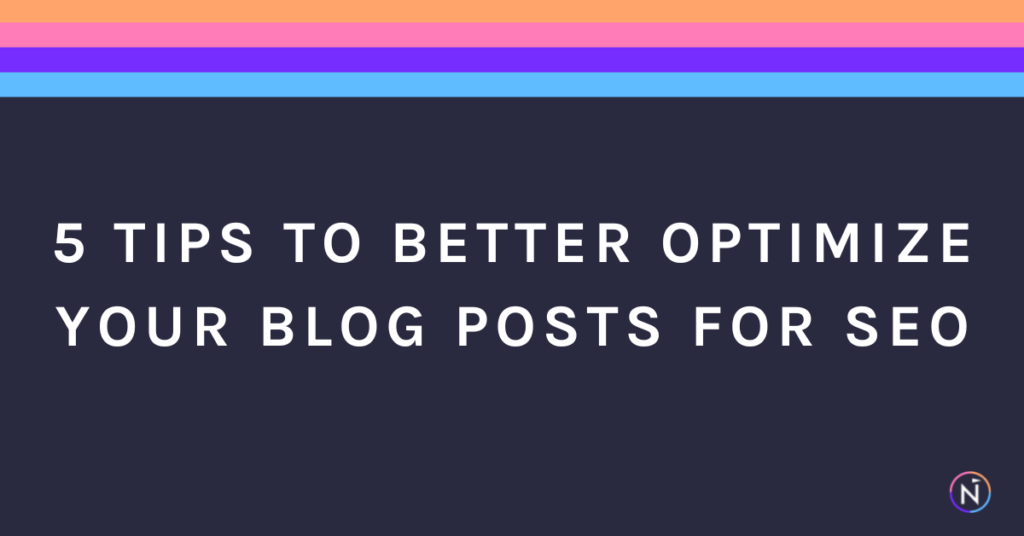SEO — it’s the name of the game for digital marketers like us. And what’s one major component of building a solid SEO strategy?
Blog posts! (Yes…this blog post is painfully meta, I’m aware).
This week, let’s break down 5 key tips & tricks to better optimize your blog posts for SEO. After all, SEO is crucial for brand awareness, visibility, and long-term success!
So let’s dive right in with tip numero uno…

1. Keyword research
Don’t just guess what your audience wants to read about, make an informed decision with keyword research!
Keyword research is an invaluable practice used by content creators, digital marketers, and SEO experts everywhere, and for good reason.
It helps you discover the topics your users are interested in based on carefully curated search engine data.
Semrush is a fantastic tool to aid in your keyword research and this article from Moz gives a detailed look into the basics and steps of keyword research.
2. Think long and hard about your title
The title of your blog post must be effective to garner lasting SEO results.
As a general rule of thumb, your blog post title should house your focus keyword and draw attention — make it click-worthy!
As previously stated in tip #1, keywords are important for SEO, but so are click-through rates. If your title is eye-catching and includes your focus keyword, you’re in business.
For a more in-depth look at how to increase click-through rates, check out this blog post.
3. A meta description is non-negotiable
A meta description is an HTML meta tag that can be added to any page.
It’s basically a short description of your article for search engines and it looks a little something like this…

See that bit of grey text under the blue headline? That’s a meta description.
Meta descriptions tell Google-ers and search engine users what your blog post, web page, landing page, etc. is about so they can assess if it’s the right choice for them to click.
Think of it as your first impression for search engines and search engine users.
Here are a few rules to follow when writing your meta description:
- Use your focus keyword at least once
- Convey your unique selling point
- Aim for about 1-2 sentences (don’t go over 155 characters!)
- Add a CTA
4. Readability & scannability is of the utmost importance
Notice how in this blog post, all of the paragraphs are only 1-2 sentences long?
That’s on purpose! In my spare time, I’m a creative writer, and short-story writing looks a lot different than blog post writing.
For blog posts, you need to keep them simple & easy to read — no long-winded, descriptive paragraphs. Scannability is vital for successfully optimizing blog posts.
And what’s scannability, you ask? Great question, I would love to tell you!
Scannability: The aggregate effect of writing and formatting techniques that compensate for the fac that most people don’t read content on the Web (thanks for the definition, uxmatters.com)
Along with readability comes proper grammar and syntax. For that, I highly recommend tools like Grammarly — they’ve saved my butt more times than I can count.
5. Don’t forget about your old blog posts
Once you’ve optimized current blog posts, don’t forget about the old(er) ones.
After all, your entire blog affects your overall SEO health and performance — don’t let old mistakes get in the way of your optimization work.
Also, keep in mind that optimization doesn’t end once you’ve published your blog post. In order to increase optimization once your post is live, be sure to do the following:
- Share it. Share your new and old posts on social, in emails, to friends & family (hey, I’ve done it before)
- Go back and add internal links. If you’ve written a new blog post that would support an old post, go back and include it as an internal link! This is a great way to optimize new and old posts.
- Keep track of search rankings. Even if your post is “old,” it’s still good practice to keep track of its search rankings. There are tons of great SEO rank tracker tools, but here at Net-Results, we use SEMrush and have no complaints!
Optimization doesn’t have to be a pain. If you have any questions about optimizing your blog posts or implementing marketing automation software (that is what we do here, after all), please don’t hesitate to schedule a quick, no-commitment, 20-minute chat with our team.
Cheers to your success,
Lexie Robbins
Marketing @ Net-Results

